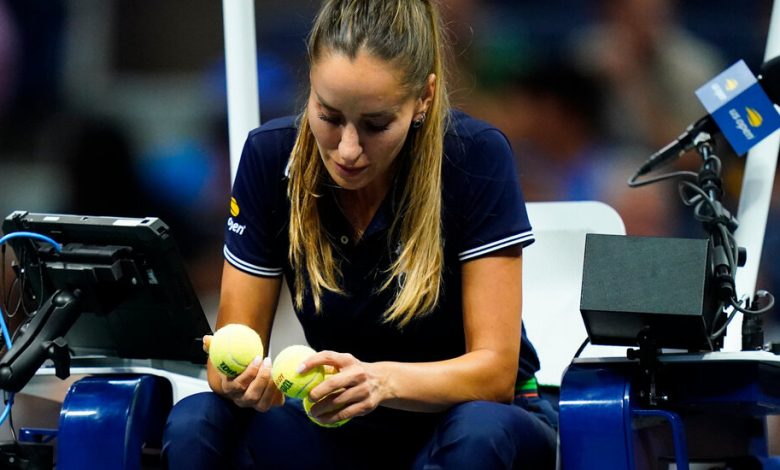Not All Tennis Balls Are Equal

Keep your eye on the ball. That’s the mantra for tennis players, from beginners to whoever lands in the finals at this year’s United States Open.
But each ball will be seen only briefly because in tournament play, six balls are used to start a match, then ditched after seven games; for the rest of that match, the balls will be replaced after every nine games. (The Open generally stocks about 100,000 new balls and goes through about 70,000 each year.)
Those life spans, punctuated by the chair umpire’s call for “new balls, please,” are necessarily brief because the balls take a beating. In the course of a ball’s court time, the pummeling causes them to get fluffier as their hairs shake loose. This slows them as they travel through the air, making it easier to control placement but more difficult to blast a winner.
The balls are changed regularly to maintain consistency of play, but also used balls feel heavier on the racket, requiring more wrist, elbow and shoulder torque to generate power. Changing them reduces the risk of injury.
Players are acutely aware of the way the balls degrade.
“When the balls are getting old, it gets tougher to hit winners and make easy points, especially on slower courts,” said the eighth-ranked Andrey Rublev of Russia.
The aging process leads players to seek smoother, less-worn balls for a first serve to gain more speed. They look for fluffier balls for the second serve to attain more control and to slow their opponent’s return.
Then the players need to adjust again when the new balls arrive.
“I’m conscious of the ways the balls change, and I have the count in my head until the new balls,” Francisco Cerundolo, the world No. 20 from Argentina, said.
Jessica Pegula, an American ranked No. 3, added that while the fans might not be aware of the shift, the players were thinking “very strategically” about the change.
The most common maneuver is switching rackets when new balls are introduced.
“I change my racket at every ball change,” said the 18th-ranked Lorenzo Musetti, of Italy, explaining that the strings lose some tension over the course of nine games and the new racket will enable a player to capitalize on the smoother, slimmer ball to hit them hard while still maintaining control. (Roger Federer used to switch rackets one game early so he’d be comfortable with the new racket when the fresh balls arrived.)
Changing rackets has become more common in the past 20 years, said Patrick McEnroe, an ESPN analyst and a former pro, although he noted that Ivan Lendl was the pioneer in making it a consistent practice timed to the new balls. In earlier eras, players used gut strings and had to change rackets more frequently, McEnroe said, but modern players are more meticulous about every detail in their game.
Also, modern synthetic strings last longer, but they may be past their peak well before they break. So while some players change rackets for new balls because they feel it’s advantageous, others simply use the balls as an automatic reminder to grab a fresh stick.
“With more explosive frames, rackets and strings that can grab the ball more to create spin, players can now feel the slightest change in tension,” McEnroe said. “There’s definitely more awareness of adapting when the new balls come in, and I think some players tinker more with their tactics as a ball goes through its life span.”
In addition to switching rackets, many players change their game plan when the new balls arrive.
The faster balls give the biggest advantage to the server, who can pound first serves or skid them out wide to win quick points, McEnroe said.
Musetti said it was important to serve well with the new balls: “I try to be more aggressive.”
Not only are the serves coming in faster, but the returns are also tougher to control, said Giuliana Olmos of Mexico, who’s ranked 18th in doubles. “When they first put new balls in, they tend to fly a lot. The other balls are old and heavy, so it’s a drastic difference and can be hard to adjust. I just remind myself and my partner and try not to go for too much, then you can start hitting normally again after a little bit.”
Echoing complaints other players (including Rafael Nadal) have made about the recent quality of the balls, Rublev said this year many new balls “are super tough to control in the first game. It feels like they’re breaking your wrist, and the balls feel like stones and fly without control.”
But even if the balls are not problematic, Cerundolo said players used more topspin on serve returns and ground strokes in the first game or two after the change. “If you hit the ball too flat, it may fly out.”
McEnroe said that while the differences in the balls and in the string tension of the new rackets were real, they were fairly small concerns for players skilled enough to be at or near the top of the pro game. Still, the issue is in players’ minds.
“Anything that gives you a little edge helps, and whether it’s a reality or not almost doesn’t matter,” McEnroe said, adding that if players barely miss a shot after the introduction of the new balls, they may blame it on the change and next time may switch rackets to enable them to control their shots better.
“Players may be overthinking the differences with the new balls a little bit,” he said, “but just because a lot of it is likely psychological doesn’t mean it’s not important.”




